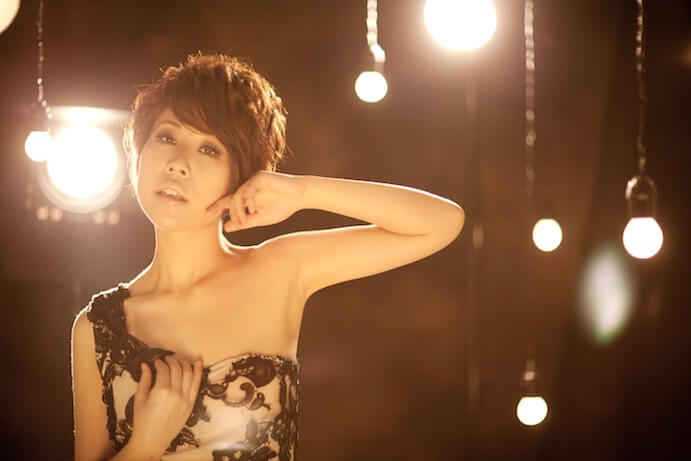Jenny Q Chai is a pianist well known for creating unconventional recitals combining live electronics, artificial intelligence technology, environmental research, and fashion. Her upcoming performance, Where Is Chopin?, investigates interactions between piano and electronics through various forms of audio/visual storytelling. The program will feature works by Jaroslaw Kapuscinski alongside Robert Schumann’s Carnaval, aided by multi-screen video projection and the AI program Antescofo.
Some of the music on this program makes use of the artificial intelligence program Antescofo. Can you explain to us exactly how it works during your performance? Do you consider the interaction with Antescofo to be a dialogue; that is, you respond as much to the program as it responds to you?
Antescofo is an AI program invented by scientist Arshia Cont in collaboration with composer Marco Stroppa at Ircam. It is a music following program; there are mics placed inside the piano to catch the sounds I make, then the sound signals are sent to Antescofo. Within milliseconds, Antescofo learns and predicts every following note I’ll be playing. Then it shoots out the according electronic sounds and visuals, which are composed and programmed by the composer. It is like playing with a live electronic musician and a visual artist in the same time. So yes, it is more of a chamber music trio setting.
Your concert features Jaroslaw Kapuscinski’s Where is Chopin? which was originally created as an installation with no live performer. How does your live performance version differ from the work’s first iteration? What compositional choices are you making in addition to Kapuscinski’s?
The most fundamental importance Mr. Kapuscinski spoke to me about regarding his music is timing, which also means rubato, the stretching in real time. This is very much in tune with Chopin’s music and performance aesthetic. I believe in interpretation of the moment, looking at all live performances as the Moment Form. The concept is both old and new. I think it was Josef Hofmann who said, “It’s great to play it this way now. But when it’s raining outside, play it differently.”
In other words, I don’t know yet exactly what I will be doing with my interpretations this Sunday at the concert. What I can guarantee will be a version that will never be identical to another, and will be completely truthful of me, in that very moment. The piece Where is Chopin? is constructed of 16 different short movements, with many inspirational quotes from Chopin, reconstructed and reinterpreted in a personal way by the composer. It gives me a lot of room for a contrasting and personalized interpretation.
Jenny Q Chai
You’ve been known to program both canonical and contemporary compositions in a multimedia setting, employing video or even theatrical lecture. Do you consider interdisciplinary performance to be a fundamental bridge between these two types of classical music? In other words, is it no longer enough to simply program the old with the new on a recital as is?
I’ve never thought just listening to a piece of acoustic music is “not enough.” For me, the world is no longer a binary form, an either/or. I no longer believe in making definitions such as old or new music, visual or acoustic music. We have created too many divisions, borders, boxes for ourselves; like categories such as “Classical Music,” “Western Art Music,” “Modernist Classical Music,” and so on. All they do is to stop people from enjoying what it is, which is just music! Alex Ross has written a great article on this topic, starting with the phrase “I hate ‘classical music’: not the thing but the name.” I’d follow by saying:”I hate the term “new music” or “multimedia.” Why don’t we just enjoy a great moment of our lives together, with all our senses?
Fashion plays an important part in your performances; you’ve designed dresses for your concerts for the past three years. What concepts informed your outfit design for this concert and what do you hope your audience will take away from it?
For me music, design, and now painting: everything comes and goes, in constant flux. All senses blend, culminating into an exuberant flow of energy. My design comes from such moments, inspired by the emotions of the music on the program, then becoming one with it. I’ll have two outfits for this concert. The first is inspired by the dreamy quality of the first piece on the program, Kapuscinski’s Oli’s Dream, with an organic flow of nature. In the second, I’ll appear as one of the many people featured in the video portion of Where is Chopin? who revealed their vivid facial expressions while listening to Chopin’s preludes.
Jenny Q Chai
You seem to have a hyper awareness of all the potential visual and aural elements that might affect an audience member during one of your performances. Do you try to manage the risk of overstimulation or distraction for an audience, or do you leave it to them to choose what to focus on and take in?
I don’t think my programs and design risk overstimulating or distracting people from experiencing the moment of music. All the elements are created as one, for one purpose, one unity of sensation. It’s an idea sort of close to Wagner’s Gesamtkunstwerk or Scriabin’s wish to blend in scents and lighting for his music. The visual and aural elements did not exist separately before, and cannot live or work without one another.
In terms of audiences’ reactions: in general, I have become more and more Taoist in approach, as I also studied cognitive science and psychology. Human cognition and the psyche are so interesting and complex, but also highly individual. As Marco Stroppa, said to me, “I drop many keys. It is up to you whichever key you pick up.”
Jenny Q Chai will perform Where Is Chopin? at Le Poisson Rouge in New York City this Sunday, January 10th. Tickets can be purchased here. More info about Jenny Q Chai can be found at www.jennychai.com.

